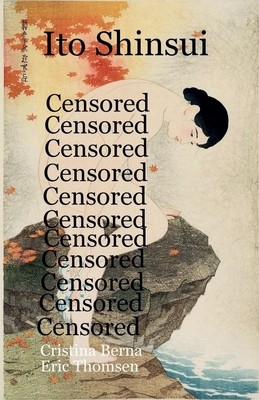
- We will send in 10–14 business days.
- Author: Cristina Berna
- Publisher: Missys Clan
- ISBN-10: 5967219153
- ISBN-13: 9785967219153
- Format: 14 x 21.6 x 0.7 cm, minkšti viršeliai
- Language: English
- SAVE -10% with code: EXTRA
Reviews
Description
This version of the title is censored on the demands of self-publishing platform BOD.es in Spain, which is a subsidiary of the German self-publishing platform BOD.de. Formally the demands are for covering up nipples on old Japanese prints. There is no improper content. The authors believe that the real reason however, is politically motivated, because it was a condition of publishing and not a result of the identification of any special audience opportunity.
However, there may just be such an audience, which this issue of the title will then accomodate.
Shinsui Ito was born 4 February 1898 in the Fukagawa district of Tokyo and died 8 May 1972.
Shinsui Itō was his pseudonym.
Shinsui designed mostly bijin-ga and only more occasionally landscape prints, see Shinsui Ito Landscapes by authors. Bijin-ga is "pretty ladies", akin to pin-up art.
Bijin-ga (美人画, びじんが, "beautiful person picture") is a generic term for pictures of beautiful women (bijin) in Japanese art, especially in woodblock printing of the ukiyo-e genre.
At the age of ten, young Hajime found employment at the Tokyo Printing Company after his fatherôs business went bankrupt, and here he began to show serious interest and talent in Nihonga, Japanese-style painting.
In 1911 he was introduced to Kaburagi Kiyokata, a renowned painter, and became Kiyokata's student. It was Kiyokata that gave Hajime his artist's name, Shinsui. When Shinsui was eighteen years old, his paintings were seen by the publisher Watanabe Shozaburo at an exhibition at Kiyokata's art school.
Ukiyo-e itself is a genre of woodblock prints and paintings that was produced in Japan from the 17th century to the 19th century. The prints were very popular amongst the Japanese merchants and the middle class of the time.
EXTRA 10 % discount with code: EXTRA
The promotion ends in 21d.20:52:18
The discount code is valid when purchasing from 10 €. Discounts do not stack.
- Author: Cristina Berna
- Publisher: Missys Clan
- ISBN-10: 5967219153
- ISBN-13: 9785967219153
- Format: 14 x 21.6 x 0.7 cm, minkšti viršeliai
- Language: English English
This version of the title is censored on the demands of self-publishing platform BOD.es in Spain, which is a subsidiary of the German self-publishing platform BOD.de. Formally the demands are for covering up nipples on old Japanese prints. There is no improper content. The authors believe that the real reason however, is politically motivated, because it was a condition of publishing and not a result of the identification of any special audience opportunity.
However, there may just be such an audience, which this issue of the title will then accomodate.
Shinsui Ito was born 4 February 1898 in the Fukagawa district of Tokyo and died 8 May 1972.
Shinsui Itō was his pseudonym.
Shinsui designed mostly bijin-ga and only more occasionally landscape prints, see Shinsui Ito Landscapes by authors. Bijin-ga is "pretty ladies", akin to pin-up art.
Bijin-ga (美人画, びじんが, "beautiful person picture") is a generic term for pictures of beautiful women (bijin) in Japanese art, especially in woodblock printing of the ukiyo-e genre.
At the age of ten, young Hajime found employment at the Tokyo Printing Company after his fatherôs business went bankrupt, and here he began to show serious interest and talent in Nihonga, Japanese-style painting.
In 1911 he was introduced to Kaburagi Kiyokata, a renowned painter, and became Kiyokata's student. It was Kiyokata that gave Hajime his artist's name, Shinsui. When Shinsui was eighteen years old, his paintings were seen by the publisher Watanabe Shozaburo at an exhibition at Kiyokata's art school.
Ukiyo-e itself is a genre of woodblock prints and paintings that was produced in Japan from the 17th century to the 19th century. The prints were very popular amongst the Japanese merchants and the middle class of the time.


Reviews